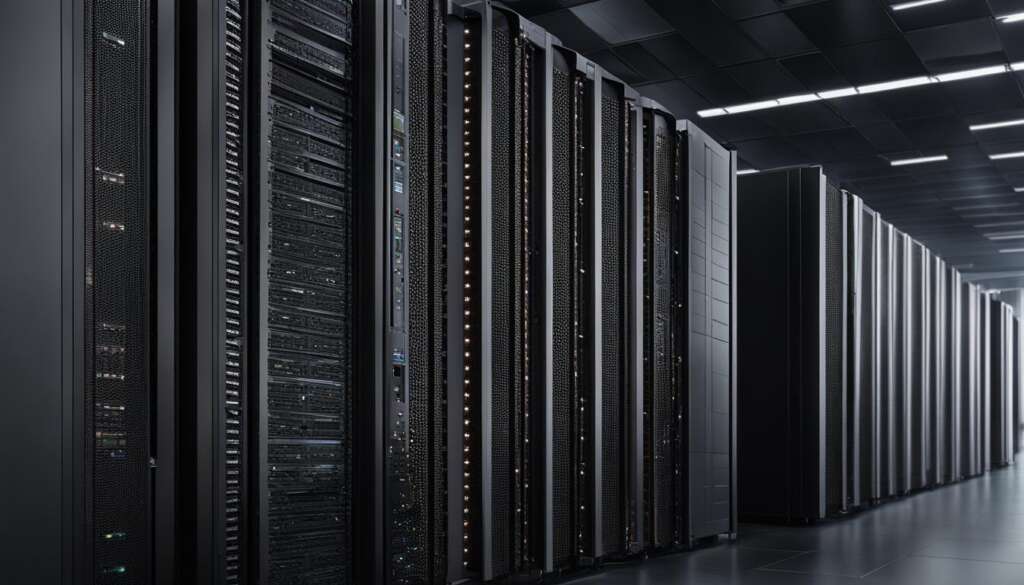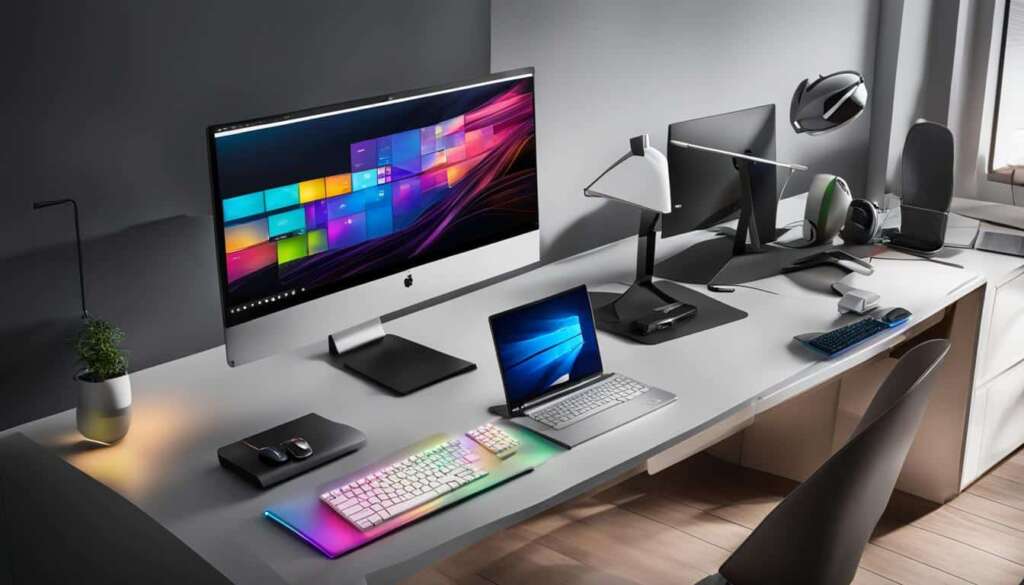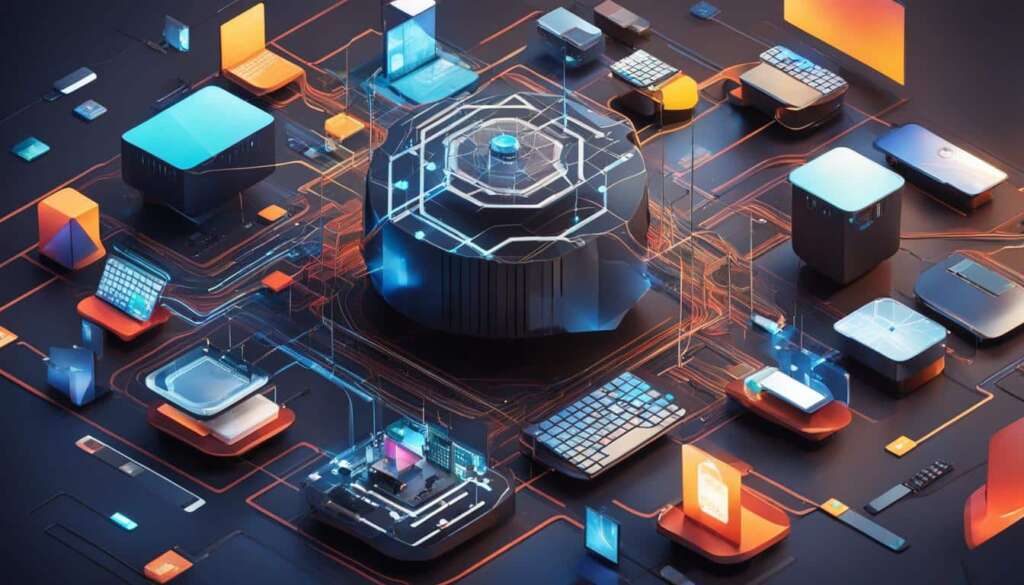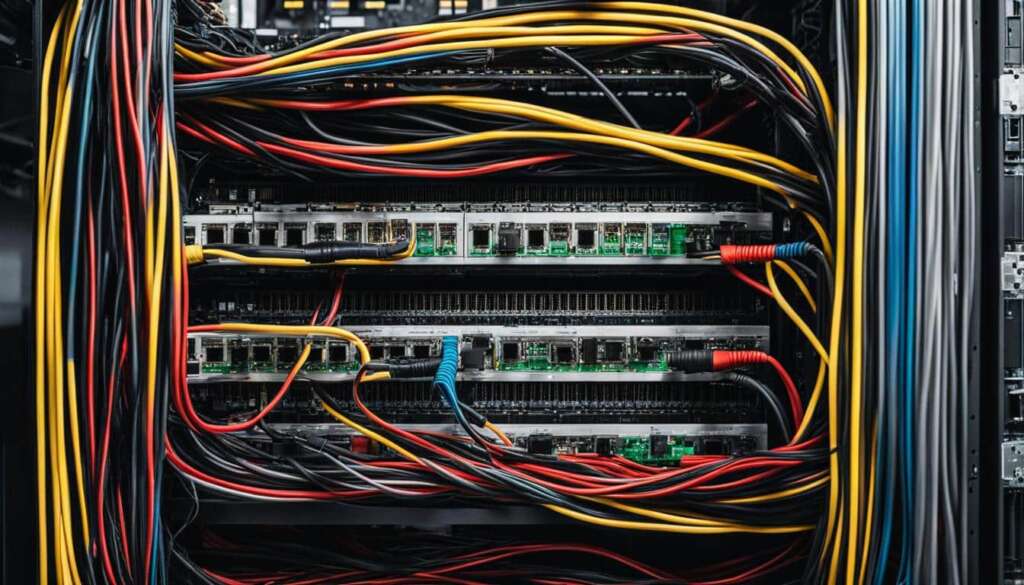Table of Contents
Welcome to a world of limitless possibilities for your business with a computer server. In today’s technology-driven era, managing and optimizing your server is crucial for seamless operations and staying ahead of the competition. Whether you’re a small startup or an established enterprise, investing in server management, monitoring, security, optimization, backup, administration, troubleshooting, and maintenance allows you to unlock the true potential of your business.
Imagine a secure and efficient infrastructure that ensures your valuable data is protected, your applications run smoothly, and your employees can work seamlessly from anywhere. A reliable computer server acts as the foundation for all your digital endeavors, enabling you to scale your operations, streamline processes, and enhance productivity.
With robust server management, you have the power to proactively monitor system performance, detect and resolve issues before they impact your business, and optimize resources to drive efficiency and cost savings. Furthermore, implementing comprehensive server security measures safeguards your sensitive data, mitigates the risk of cyber threats, and ensures regulatory compliance.
Efficient server backup and administration processes provide peace of mind, knowing that your critical data is protected and easily recoverable in the event of a disaster. Additionally, regular server maintenance helps to prolong the lifespan of your hardware, optimize system performance, and keep your business running smoothly.
Embracing the potential of a computer server empowers your business to achieve new heights of success and opens the doors to endless opportunities. Whether you’re looking to expand your operations, improve collaboration, or enhance customer experiences, a well-managed and secure server infrastructure is the key to unlocking your business’s full potential.
Continue reading to discover how remote desktop technology can further revolutionize your business and take it to the next level.
Understanding Remote Desktop Technology
Remote desktop technology revolutionizes the way we access and control computers and virtual desktops from remote devices. It empowers individuals and organizations to interact with a remote system from anywhere, as if they were physically present. This technology relies on a set of advanced protocols and technologies that facilitate seamless connectivity and remote operation.
One of the key components of remote desktop technology is the concept of virtual machines. These virtual machines are created on a physical server and have equal computing power, irrespective of the device used for remote access. This ensures consistent performance and eliminates the limitations imposed by individual devices.
The Remote Desktop Protocol (RDP), developed by Microsoft, is one of the most commonly used protocols in remote desktop technology. It enables secure and efficient communication between the remote device and the server, facilitating seamless remote access and control.
Each employee typically has their own virtual machine in a remote desktop environment. The failure of one virtual machine does not affect the performance of other remote desktops, ensuring uninterrupted workflow for all users. Meanwhile, an administrator overseeing the system can monitor employee activity and configure programs, such as meeting schedulers, to streamline collaboration.
This remote desktop technology offers numerous benefits, including improved productivity, enhanced collaboration, and simplified management of remote systems. It enables individuals and organizations to harness the power of cloud-based computing and access their data and applications securely from any location.
Key Features of Remote Desktop Technology
| Remote Access and Control | File Sharing and Transfer | Multi-platform Compatibility |
|---|---|---|
| Gain seamless access to a remote system and control it as if you were physically present. | Easily share and transfer files between remote and local systems, enhancing collaboration. | Compatible with various platforms and devices, allowing flexible access and operation. |
| Session Recording and Logging | Printing and Peripheral Device Support | Security Features |
| Record and log remote sessions for auditing, troubleshooting, and training purposes. | Print documents and enjoy support for peripheral devices, ensuring a seamless remote experience. | Utilize robust security features, such as encryption and authentication, to protect data and ensure secure remote connections. |
Why Do You Need A Remote Desktop Technology?
Implementing remote desktop technology, such as VDI (Virtual Desktop Infrastructure) and RDP (Remote Desktop Protocol), can revolutionize the way your small business operates. By creating a remote desktop environment on a single server, you can unlock a range of benefits that enhance efficiency, boost data security, and empower your employees to work productively from anywhere.
One of the immediate advantages of remote desktop technology is the opportunity for significant hardware savings. Instead of equipping each employee with individual desktop computers or laptops, you can centralize your resources on the server, allowing employees to access their virtual desktops from any device with an internet connection. This consolidation not only reduces hardware costs but also eliminates the need for frequent upgrades, maintenance, and repairs.
Moreover, remote desktop technology enables substantial staff savings. Without the need to manage and maintain individual machines, you can streamline your IT support staff or rely on third-party support, resulting in cost reductions. By allocating resources more efficiently, you can redirect your budget towards enhancing other critical areas of your small business.
Enhancing data security is crucial for any business, regardless of its size. With a remote desktop infrastructure, your sensitive data remains securely stored on the central server, minimizing the risk of data breaches. Additionally, regular backups and robust security measures can be implemented to ensure data integrity, protecting your business from potential threats.
By embracing remote desktop technology, you simplify work processes for your employees. With the ability to access their virtual desktops from any location, they can collaborate seamlessly, boosting productivity and efficiency. Whether it’s approving documents, attending virtual meetings, or sharing files, the flexibility provided by remote desktop technology promotes a more agile and adaptive work environment.
Furthermore, remote desktop technology facilitates remote work, an increasingly popular and necessary mode of operation. In a world where flexibility and work-life balance are valued, providing your employees with the means to work remotely cultivates a motivated and satisfied workforce. It also allows you to tap into talent pools beyond geographical limitations, granting you access to skilled individuals regardless of their physical location.
Overall, the adoption of remote desktop technology brings numerous advantages to small businesses. From hardware and staff savings to enhanced data security and improved employee work facilitation, remote desktop technology empowers your business to thrive in the modern digital landscape, where flexibility and efficiency are key.
Key Features of Remote Desktop Technology
Remote desktop technology offers a plethora of features that enhance productivity, streamline collaboration, and strengthen security. Whether you are a small business owner or part of a large organization, these key features can revolutionize the way you work.
Remote Access and Control
With remote access capabilities, you can connect to your computer or virtual desktop from anywhere in the world. This allows you to access your files, applications, and resources as if you were sitting in front of your computer. Whether you’re working from home, on a business trip, or in a different office location, remote access ensures you never miss a beat.
File Sharing and Transfer
Effortlessly share and transfer files between your local device and the remote desktop. This eliminates the need for complex email attachments or external storage devices. Collaborate seamlessly with team members by quickly and securely sharing important documents, presentations, or files.
Multi-platform Compatibility
Remote desktop technology is designed to be compatible with various platforms, including Windows, Mac, Linux, and mobile devices. Regardless of the operating system you use, you can connect to your remote desktop with ease, ensuring flexibility and convenience.
Session Recording and Logging
Keep track of your work sessions by recording and logging your activities. Session recording allows you to review past sessions, retrieve important information, and analyze user behavior. This feature is particularly useful for training purposes, auditing, or troubleshooting.
Printing Support
Print documents from your remote desktop to a local printer, eliminating the need to transfer files or use complex workarounds. Enjoy seamless printing capabilities and ensure all your important documents are easily accessible and printable.
Security Features
Remote desktop technology prioritizes security to protect your sensitive data. Encryption ensures that your information is transmitted securely over the internet, safeguarding it from unauthorized access. Authentication protocols verify the identity of users, preventing unauthorized individuals from gaining access to your remote desktop.
| Key Features | Description |
|---|---|
| Remote Access | Connect to your computer or virtual desktop from anywhere in the world. |
| File Sharing and Transfer | Effortlessly share and transfer files between local and remote devices. |
| Multi-platform Compatibility | Compatible with various operating systems, including Windows, Mac, Linux, and mobile devices. |
| Session Recording and Logging | Record and log work sessions for training, auditing, or troubleshooting purposes. |
| Printing Support | Print documents from your remote desktop to a local printer. |
| Security Features | Ensure the security of your data through encryption and authentication protocols. |
These features are just the tip of the iceberg when it comes to remote desktop technology. Embrace the power of remote access, seamless collaboration, and enhanced security for a truly transformative work experience.
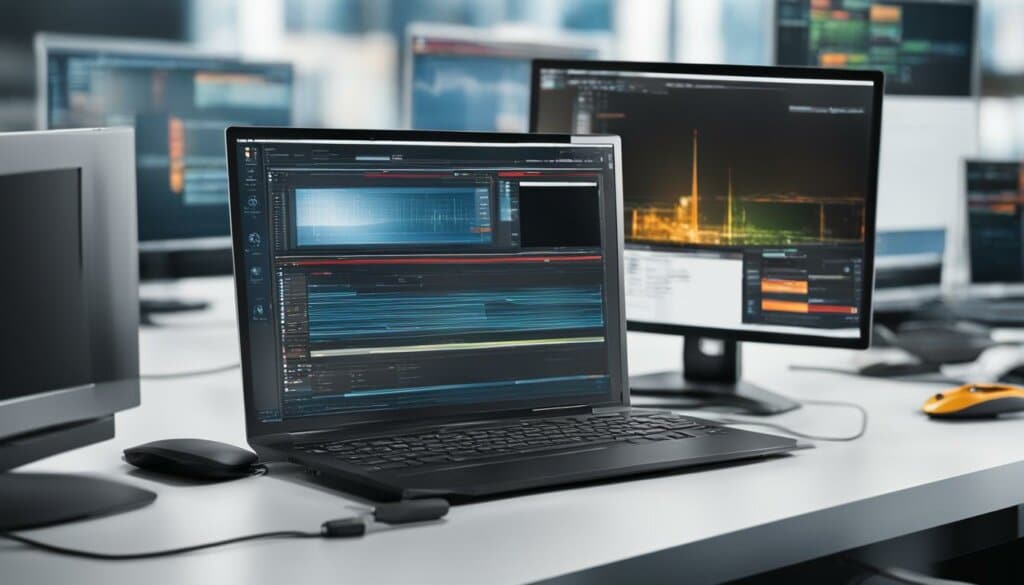
Advantages of Remote Desktop Technology
Implementing remote desktop technology brings several advantages to businesses, providing significant savings and enhanced capabilities. Let’s explore the key benefits:
Savings on Hardware and Energy Bills
With remote desktop technology, businesses can reduce their hardware expenses. Instead of purchasing individual devices for each employee, a single server is utilized to create virtual machines. This leads to hardware savings as fewer physical machines are required. Additionally, by consolidating computing power, energy consumption is optimized, resulting in lower energy bills.
Efficiency Gains
Remote desktop technology improves overall efficiency within an organization. Employees can access their virtual desktops from anywhere, eliminating the need for them to be physically present in the office. This flexibility enables remote work, increases productivity, and facilitates collaboration across geographical locations and time zones.
Savings on Staff
By centralizing IT management and maintenance on a single server, remote desktop technology reduces the need for extensive on-site technical support. This translates into substantial cost savings on IT staff and support resources. System updates, software installations, and troubleshooting can be performed remotely, minimizing downtime and maximizing workforce efficiency.
Improved Data Protection
Data security is of utmost importance for businesses. With remote desktop technology, sensitive information remains centralized on the server, rather than being dispersed across multiple individual devices. This centralized approach enhances data protection as it allows for easier implementation of security measures and regular backups. In the event of a device loss or failure, data remains safe and accessible from the server.
In conclusion, remote desktop technology offers businesses a range of advantages including hardware and energy savings, increased efficiency, cost savings on staff, and improved data protection. By embracing this technology, businesses can empower their workforce and enhance their overall competitiveness.
Disadvantages of Remote Desktop Technology
While remote desktop technology offers numerous advantages, it’s important to be aware of the potential downsides that come with its implementation. These disadvantages include a reliance on stable internet connectivity and the increased risk of data breaches and security risks if not properly managed and secured.
One of the primary challenges of remote desktop technology is the dependence on internet connectivity. In order for users to access and control their remote desktops, a stable internet connection is crucial. Without a reliable and fast internet connection, users may experience lag, delays, or even disconnections, hampering productivity and causing frustration.
Furthermore, the nature of remote desktop technology opens up opportunities for potential security breaches and data risks if not implemented and managed with care. Transmitting sensitive data over the internet introduces vulnerabilities that malicious attackers can exploit. Without robust security measures, unauthorized access, data breaches, and the compromise of confidential information become significant concerns.
Therefore, it is imperative for businesses and individuals utilizing remote desktop technology to prioritize security and undertake proper measures to safeguard their systems and data. Implementing strong encryption, user authentication protocols, and regular monitoring can enhance the security of remote desktop connections and mitigate the potential risks.
| Disadvantages | Impact |
|---|---|
| Dependence on stable internet connectivity | Limited access and potential disruptions |
| Data breaches and security risks | Potential compromise of sensitive information and confidential data |
It is crucial for businesses and individuals to weigh the advantages and disadvantages of remote desktop technology when considering its implementation. While the benefits can be significant, it is essential to address the challenges of internet connectivity, data breaches, and security risks to ensure a secure and efficient remote desktop experience.

Conclusion
In conclusion, a computer server equipped with remote desktop technology offers numerous advantages for businesses, including cost savings, improved efficiency, enhanced data protection, and convenient remote access capabilities. By implementing this technology, businesses can streamline their operations and optimize their resources.
The use of a computer server eliminates the need for individual PCs and reduces hardware costs. With a central server, businesses can allocate computing power as needed, saving money on purchasing and maintaining multiple devices. Additionally, server management and maintenance tasks can be centralized, resulting in more efficient operations and reduced staff requirements.
Remote desktop technology empowers businesses by enabling employees to access their desktops and work remotely, increasing flexibility and productivity. Whether employees are at the office, on the road, or working from home, they can easily connect to their virtual desktops, access files, and collaborate with colleagues. This flexibility not only enhances work-life balance but also ensures seamless operations in situations such as emergencies or unexpected disruptions.
However, it is crucial for businesses to be aware of the potential disadvantages and security risks associated with remote desktop technology. Dependence on stable internet connectivity is essential for uninterrupted access to the remote desktop. Furthermore, businesses must implement robust security measures, including encryption and authentication, to safeguard sensitive data from potential breaches.
FAQ
What is a computer server?
A computer server is a powerful computer that stores, manages, and delivers data and services to multiple users or client devices.
What is server management?
Server management refers to the tasks and processes involved in monitoring, configuring, and maintaining the performance, security, and availability of a server.
What is server monitoring?
Server monitoring is the practice of continuously tracking and analyzing the performance and availability of a server to identify and resolve any issues that may arise.
Why is server security important?
Server security is crucial to protect sensitive data, prevent unauthorized access, and ensure the confidentiality, integrity, and availability of server resources.
What is server optimization?
Server optimization involves fine-tuning the configuration and settings of a server to maximize its performance, efficiency, and resource utilization.
What is server backup?
Server backup is the process of creating and storing copies of server data to prevent data loss in the event of hardware failures, software glitches, or human errors.
What is server administration?
Server administration refers to the tasks and responsibilities involved in managing and overseeing the operation, configuration, and maintenance of a server.
What is server troubleshooting?
Server troubleshooting involves identifying, diagnosing, and resolving issues or malfunctions that may occur with a server, ensuring its smooth operation.
What is server maintenance?
Server maintenance encompasses a range of activities, including regular updates, patches, repairs, and preventive measures taken to keep a server in optimal working condition.

